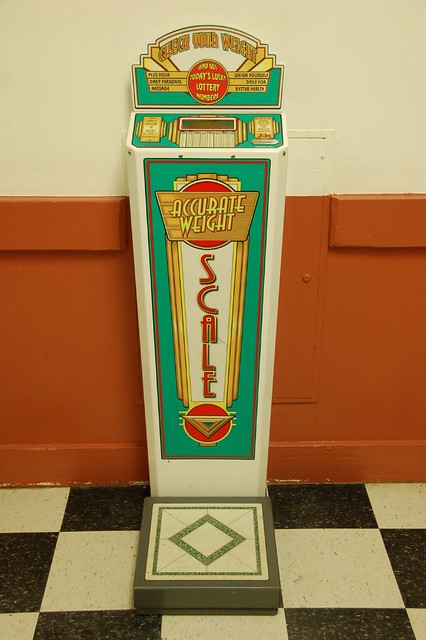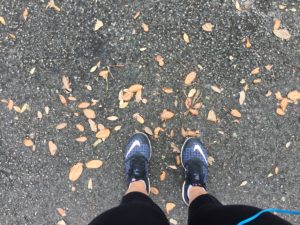Tracking macros is hot right now, but admittedly, it can be a pain in the ass.
Weighing out every bite of food is a tedious task, and for some people it leads to obsession and neurosis. Others get overwhelmed by the amount of detail required.
Don’t get me wrong. Tracking is very effective if you do it correctly, and it works great for some people (myself included). But that doesn’t mean everyone needs to be hooked to MyFitnessPal to reach their body composition goals.
But if you’re looking to change your body, portion size is one of the most important factors. So what is one to do if you don’t want to fuss with measuring spoons, cups, and scales?
Simple, you use your hand.
I first learned of this method from Precision Nutrition. (Here’s a handy infographic about it. Handy…get it?)
Basically, your palm measures proteins and starches. Your fist measures vegetables. And your thumb measures fats. Women get one serving of each per meal, and men get two. Aim to eat 3-5 meals a day using this template.
I decided to use this method for a few of my meals and then track the caloric intake of each meal. These were the results:

MEAL 1 – Chicken burger with pita, caramelized onions, arugula, cheese and plantains. 406 cals
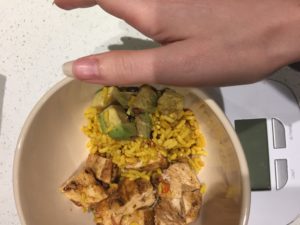
MEAL 2 – Chicken burrito bowl. This came as part of my meal delivery service and is an example of a hodge podge meal that might be a little difficult to measure because everything is mixed up. So using my hand for comparison, I separated the amount of chicken, rice, and avocado I wanted from the original batch. 264 cals
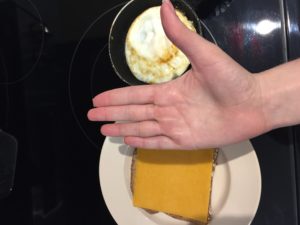
MEAL 3 – This is the breakfast that I have every day. One egg, one slice of Ezekiel bread and one slice of cheddar cheese. Little low on protein and higher on fat than I’d prefer, but whatever. 257 cals
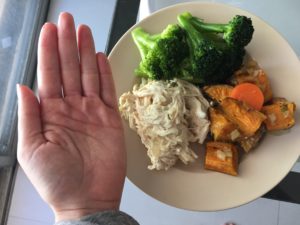
MEAL 4 – Stewed chicken, broccoli and sweet potato. Probably the most straight-forward meal I had. 300 cals
Using my hand to measure my food was very effective in controlling my portions. In fact, so much so that these calories are lower than what I would normally eat if I were trying to lose fat. For a deeper discussion on this method and the way I used it with my meals, please watch the video above.
Using this method, you might come across a few obstacles:
- Measuring foods that have mixed macros. For example, eggs and cheese have both fat and protein. So which food group do you count them towards? You can either count the food towards its largest macro or count it as both macros. I’d count whole eggs as both fat and protein. You just wouldn’t include additional fat sources since you’re already getting that in the egg. For cheese it depends on how fatty it is. Generally speaking, cheese should count towards fat unless you have a lower-fat variety like string cheese. For beans, which can be protein and carbs, I’d count as carbs unless you’re a vegetarian.
- Foods that have an odd shape or no shape. It can be hard to compare foods like hard boiled eggs, slices of cheese, and oil to your hand. Just do your best to estimate sizes. Remember that this method isn’t about perfection or precision. If sliced cheese were to be your protein, it will probably be about the size of your palm but you’d need maybe 2 slices to meet the thickness of your palm. For oil, try to use an amount that’s close to thumb size.
- Meals that have mixed ingredients. Think salads or rice bowls. Do your best to eyeball it. Worst case scenario, eat 3 palms/fists of food for women and 5-6 palms/fists for men.
Don’t overthink it. The whole point of this method is to make things less complicated, so in some cases you’re going to have to use your best judgement. In the video there are some scenarios where I don’t have perfectly portioned food, so watch it to see examples of how to navigate those situations.
Now for those who do track, I’ve got something for you:
So let’s say you’ve been faithfully entering your meals into MyFitnessPal, but your progress has halted despite hitting your targets.
WTF, right? It’s already a mission to log your food, and to not seeing any payoff is incredibly frustrating.
There are a number of reasons why this might be happening. The most common culprits are eyeballing your measurements and not tracking bites and nibbles. The good news is that once you figure out the hole in your tracking method, progress resumes.
If you’re tracking but stuck at a plateau, I created a Tracking Troubleshooter guide to help you do a little detective work. It goes over the top 6 mistakes people make when tracking their food. And it’s totally free. Get access by clicking the button!


